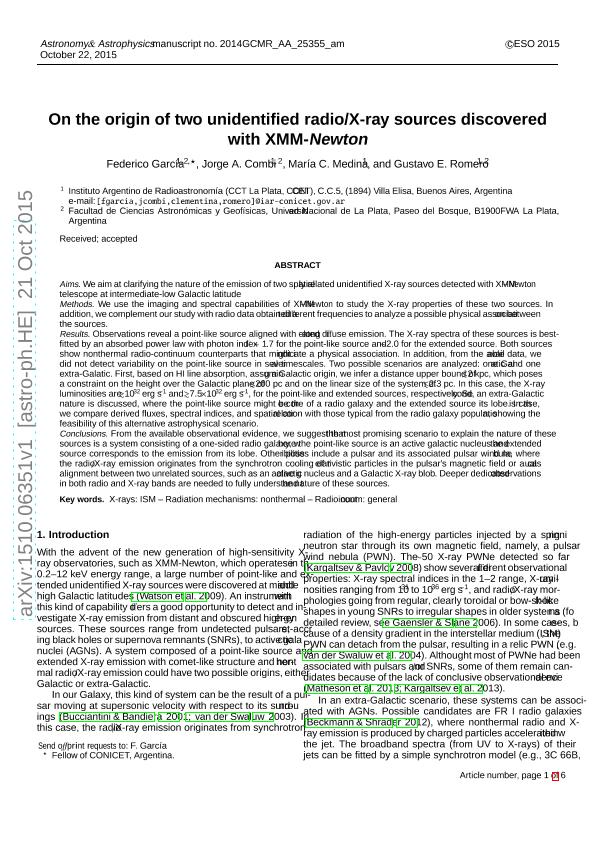Artículo
On the origin of two unidentified radio/X-ray sources discovered with XMM-Newton
Fecha de publicación:
12/2015
Editorial:
EDP Sciences
Revista:
Astronomy and Astrophysics
ISSN:
0004-6361
Idioma:
Inglés
Tipo de recurso:
Artículo publicado
Clasificación temática:
Resumen
Aims. We aim at clarifying the nature of the emission of two spatially related unidentified X-ray sources detected with XMM−Newton telescope at intermediate-low Galactic latitude Methods. We use the imaging and spectral capabilities of XMM−Newton to study the X-ray properties of these two sources. In addition, we complement our study with radio data obtained at different frequencies to analyze a possible physical association between the sources. Results. Observations reveal a point-like source aligned with elongated diffuse emission. The X-ray spectra of these sources is bestfitted by an absorbed power law with photon index Γ ∼ 1.7 for the point-like source and ∼2.0 for the extended source. Both sources show nonthermal radio-continuum counterparts that might indicate a physical association. In addition, from the available data, we did not detect variability on the point-like source in several timescales. Two possible scenarios are analyzed: one Galatic and one extra-Galatic. First, based on HI line absorption, assuming a Galactic origin, we infer a distance upper bound of .2 kpc, which poses a constraint on the height over the Galactic plane of .200 pc and on the linear size of the system of .2.3 pc. In this case, the X-ray luminosities are &1032 erg s−1 and &7.5×1032 erg s−1 , for the point-like and extended sources, respectively. Second, an extra-Galactic nature is discussed, where the point-like source might be the core of a radio galaxy and the extended source its lobe. In this case, we compare derived fluxes, spectral indices, and spatial correlation with those typical from the radio galaxy population, showing the feasibility of this alternative astrophysical scenario. Conclusions. From the available observational evidence, we suggest that the most promising scenario to explain the nature of these sources is a system consisting of a one-sided radio galaxy, where the point-like source is an active galactic nucleus and the extended source corresponds to the emission from its lobe. Other possibilities include a pulsar and its associated pulsar wind nebula, where the radio/X-ray emission originates from the synchrotron cooling of relativistic particles in the pulsar’s magnetic field or a casual alignment between two unrelated sources, such as an active galactic nucleus and a Galactic X-ray blob. Deeper dedicated observations in both radio and X-ray bands are needed to fully understand the nature of these sources.
Archivos asociados
Licencia
Identificadores
Colecciones
Articulos(IAR)
Articulos de INST.ARG.DE RADIOASTRONOMIA (I)
Articulos de INST.ARG.DE RADIOASTRONOMIA (I)
Citación
García, Federico; Combi, Jorge Ariel; Medina, Maria Clementina; Romero, Gustavo Esteban; On the origin of two unidentified radio/X-ray sources discovered with XMM-Newton; EDP Sciences; Astronomy and Astrophysics; 584; 12-2015; 65-71
Compartir
Altmétricas




